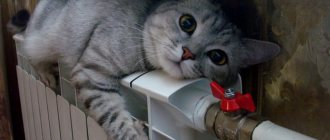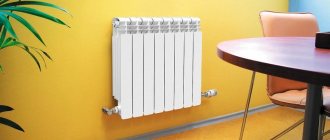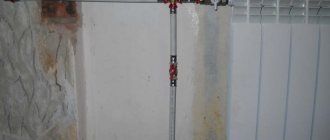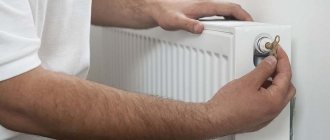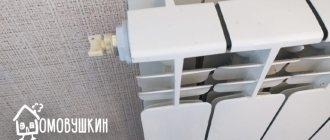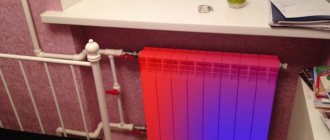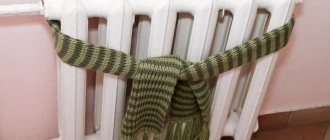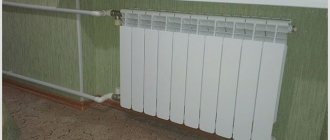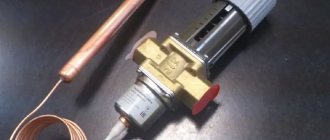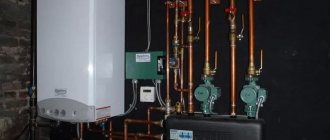Quite often in residential apartment buildings during the heating season you can encounter the following problem: the riser is hot, but the radiators are cold. This applies to both new buildings and old houses. Residents in most cases do not know how to cope with such a situation. That is why their attempts to repair the heating system on their own do not lead to the desired result. In this matter, you definitely need help or advice from a specialist. After all, only a person who has the necessary knowledge and experience can solve the problem of why the pipes are hot and the radiators are cold.
Causes
One of the reasons for insufficient heating of the battery is pipe corrosion
In fact, the sewer riser is a finicky thing. Therefore, there may be several reasons why the water supply risers are hot, although the radiator itself is cold. Let's look at the most common ones.
- The water supply valves are out of order or simply blocked in the basement. Through this valve, water flows through the main line to the apartments. Therefore, since it is blocked there, it means that heat is not flowing.
- There is an option in which the pipe was damaged during the process of welding the riser to the main line.
- It also happens that when installing the heating system riser, the technician left some foreign object in the pipe. Rags, mittens, and sometimes even stones and animals were often pulled out from there.
- An option with incorrect installation of heating pipes in other rooms, in the kitchen, due to which water does not enter the radiator, but passes by.
- A small amount of coolant, that is, water, can pass through the water supply risers. This situation may concern the entire house or a separate entrance.
- It is possible that the water supply risers, like the entire heating system, were simply adjusted and configured incorrectly, which is why the required amount of water does not flow to the heating radiators in the apartment building.
Why are the batteries in the apartment cold? Let’s find out the reasons
First you need to make sure that the heating is really turned on, and the heating system of the apartment receives coolant at the required temperature. You should start worrying if:
- the risers are hot, but the radiators are not,
- the neighbors have heat, but you don’t,
- the battery does not warm up completely (only from the bottom or top, or from one side),
- the radiator is slightly warm, and the riser is boiling water,
- the pipes made a lot of noise for more than two days, but heat still did not enter the apartment,
- The housing office told you that heating was installed in your house more than a week ago, but the radiators and risers are cold.
If your risers are making noise but not warming up, it means the heating is just starting up. Perhaps the plumbers are removing air from the system, or a leak has been discovered in someone's house. In this case, they can repeatedly pour water into the system and drain it. If there is no noise in the pipes for more than two days, and no heat has arrived, you can already call the management company and tell them about your situation.
In the absence of problems with the central network, the causes of cold radiators include:
USEFUL INFORMATION: Who must change batteries in a privatized apartment by law
- presence of air pockets in the system;
- clogged batteries;
- Incorrect connection of heating network elements.
In each situation, a certain amount of work will need to be done to make cold radiators hot.
How to eliminate air locks in radiators ↑
Air lock is the most common cause of cold radiators. The appearance of air is a natural process caused by heating the water, sudden filling of the system, and a violation of the tightness. Fixing this problem is not difficult if the system is equipped with bleed valves. On modern radiators they are located at the top of the product and operate without intervention, periodically bleeding air from the batteries. If automation is not provided, then the valve is opened manually and air is released until water appears.
Older type heating appliances do not have such taps. In this case, you will have to work a little and remove the plug. Before you start unscrewing, be sure to place the basin on the floor. Under no circumstances should the lid be completely unscrewed; it should only be unscrewed slightly until a barely audible hiss appears. At this point, you need to put the key aside and wait until all the excess air comes out of the system and water begins to ooze out. After this, the plug must be carefully tightened. Just in case, you can leave the basin for a while to make sure that water does not drip.
It is not allowed to completely unscrew the plug! This may cause the apartment to flood!
Basic malfunctions of heating systems and their elimination
Air jams
Air pockets occur in radiators and pipes and interfere with the normal circulation of water in the heating system. They appear for various reasons:
- violation of the technology for filling the system with water after the summer period;
- non-compliance with water deaeration regime;
- performing repairs with disassembling pipelines;
- failure to observe slopes when installing the heating system;
- air leakage through leaky joints.
To remove air from the system, use a Mayevsky valve installed on the radiator. You should open it, wait until the air comes out, the hissing stops, and the water begins to pour out calmly without bubbles. After this, the valve is closed. Don't forget to provide a container or towel to drain the water.
Old cast iron batteries do not have Mayevsky taps. The air is released without completely unscrewing the plugs at the ends of the radiators. It is better to entrust this operation to plumbers - if you unscrew the plug completely, you can flood the apartment.
>
Clogged water filter of the heating system
Sometimes there is an arbitrary decrease in the temperature of the “last” battery in the row. Then it is possible to cascade shutdown of other batteries in front of it. Typically, the reason for such an “abnormal” decrease in temperature is the filters of the heating system. This filter must be removed and cleaned thoroughly. During the first start-up, there may be debris in the water that is pumped into the heating system. To prevent this debris from entering the heating boiler heat exchanger, a filter is installed on the return pipe in front of the boiler. Usually one such filter is installed, but sometimes you can see several installed almost in front of each battery. This setup doesn't make any sense. After cleaning, the radiators in the house will no longer be cold.
Read also: Bathroom in a rented apartment
Pipelines: reasons for low heating
Determining air pockets in batteries using a thermal imager
Failures in the heating mode are typical for a two-pipe heating system. In this case, the supply line that distributes the coolant to the radiators does not heat. Identification of the “problem” area can be done by measuring the temperature on the surface of the pipes or a thermal imager.
Natural circulation
Pipe slope for heating with natural circulation
What could cause such problems? If the heating does not heat well, the slope of the line may not be observed. This only applies to natural circulation systems. According to the standards, the slope of the pipes should be 10 mm per 1 m.p. In addition, the direction is taken into account - from the accelerating riser to the radiators. For the return pipe, the slope must be towards the boiler.
At the first stage, it is necessary to measure this indicator using a building level. If it meets the standard, but the heating radiator does not heat, there is a possibility of air pockets forming. In this case, an integrated approach is recommended, which includes the following steps:
- Measuring the angle of inclination. If necessary, change it to the required value;
- Flushing pipes to remove limescale;
- Filling the system with coolant with open Mayevsky taps on the radiators.
This technique will eliminate the low heat transfer rate of the heating system.
To improve circulation, a circulation pump can be installed in open systems. If it overheats, you need to install an additional one. This is often necessary for branched heating systems.
Forced coolant circulation
Operating principle of the air vent
For a system with forced movement of water in pipes, the formation of air locks can be avoided by using an air vent installed at the top of the system. In part, it performs the functions of an open expansion tank, but it does not reduce the pressure in the pipes to a critical level. Its absence is an indirect cause of poor heating of the radiator.
The specificity of closed heating systems is that it is not necessary to comply with the installation level of the pipes. However, when the critical heating level of the coolant is exceeded, steam is released, which is the main cause of air locks. Since air has a lower density than water, it will concentrate in the upper region of the pipeline sections. If heating radiators in a closed system do not heat well, the reason may be a decrease in the volume of coolant in the pipes due to air resistance.
What needs to be done in this case? First of all, check the functionality of the air vents. If the valve is idle for a long time, it may become covered with limescale, which makes it impossible to open it under air pressure.
In addition to this factor, it is necessary to take into account the excess of hydraulic resistance in the system. This is why the heating battery does not heat if the initial calculation is incorrect. Therefore, before you begin installing a new system or upgrading an old one, you should perform the calculation of the operational and technical parameters:
- Selection of pipes of the appropriate diameter - the larger it is, the lower the hydrodynamic resistance. However, this increases the volume of water;
- The likelihood that a two-pipe heating system will not heat is significantly less than that of a single-pipe one. Therefore, it is preferable to install radiators with parallel connections;
- Heating of the heating circulation pump occurs due to incorrectly selected power. It directly depends on the calculated hydrodynamic parameters.
For what reasons may the radiator not heat up? This may be due to an incorrectly selected radiator model. Each of them has a certain heat transfer rate depending on the thermal operating conditions of the system. These data are indicated in the device passport. If you choose the wrong model, then even with ideal operation of the heating system, the radiator simply will not heat up to the required temperature.
The video shows the main reasons for poor radiator heating for a single-pipe heating system:
Connection errors
Another reason why batteries may remain cold is incorrect connection of heating system elements. The biggest mistake is connecting radiators to pipes, in which water is supplied from below. In this case, the sections are heated unevenly, and part of it remains cold. This is most often typical for side connections. What should I do to ensure that the surface of the radiators heats up evenly and the apartment becomes warm? To do this, you need to correctly connect them to the system.
USEFUL INFORMATION: How to install a tap on a radiator
Too many sections can also contribute to uneven heating, since coolant circulation is difficult. A special extension cord connected to the pipe that supplies hot water to the battery will help improve it.
Expert opinionAnton Tsugunov Expert builder. Entrepreneur. 17 years of experience. More than 100 completed objects.
Insufficient water pressure in the system
As you know, all heating systems are divided into two main types: gravity (gravity) and forced. In the latter case, a water pump is installed, which drives the coolant through the pipes, thereby ensuring uniform heating of the radiators throughout the house.
In the gravitational scheme, movement is achieved due to the difference in density of cold and hot water. In this case, the boiler should be installed at the lowest point, and the expansion tank at the top. This option for installing a heating system can answer the question of why one battery is hot and the other is cold. The thing is that hot water warms up radiators located in close proximity to the boiler, while those located far from it lack coolant movement and do not heat up.
The solution in this case would be to install a circulation pump, which will provide additional acceleration to the hot water moving through the pipes. It is better to perform the installation through a bypass; this will allow, in the event of a breakdown, to remove the device without draining the system and stopping the heating.
Incorrect connection
Incorrect pipe connection is one of the possible reasons for reduced radiator efficiency. This is a gross mistake; experienced craftsmen do not make such mistakes; most often they arise after the work is performed by amateurs.
Incorrect radiator installation
The return pipe is connected to the upper pipe, the supply pipe is connected to the lower pipe. As a result, a range of related problems arise:
- The circulation of water and the full operation of the heating system are completely disrupted.
- The efficiency of the radiator and its heat transfer decrease; water is unable to completely fill all sections.
- The process of draining liquid from the battery is disrupted.
Preventing heating problems
Preventative work should be performed in the summer. It is better to combine them with major or current repairs. For the heating system to work properly, you need to:
- analyze the heating operation in the previous winter, find weak points;
- check the operation of shut-off valves, repair or replace faulty ones;
- if Mayevsky taps or valves for supplying coolant to heating devices are missing, they should be installed;
- check the slopes of the supply pipes, eliminate violations, if this is not possible, install Mayevsky taps in problem areas;
- flush or replace radiators that did not heat up enough during the previous heating season.
Prepare your heating system for operation in the summer and the likelihood of failures will be greatly reduced.
What to do if the batteries are cold and the housing office does nothing?
Cold batteries in an apartment in an apartment building? Why do radiators heat poorly?
Based on the law, after drawing up a report, the housing maintenance office is obliged to respond and fix the problem within 7–10 days. If this does not happen, residents have the right to file a complaint with higher authorities.
This can be done by means of a registered letter, a document sent with a notification, or, best of all, by delivering it yourself.
General conditions for writing an application
An important condition is that the complaint must be written in 2 copies. Employees accepting the document are required to put a stamp, signature, date and assign an incoming number. The country's legislation does not provide for a uniform template for statements of this kind, so it is written arbitrarily.
What should be included in a complaint against the housing office and its annexes:
- the essence of the claim is clearly defined;
- evidence of poor-quality heat supply - your copy of the application, a drawn up act, etc.;
- reason for lack of heating;
- response from housing and communal services in writing indicating the reason for inaction;
- photocopies of heating receipts - it is important that payments are made on time;
- information about the owner - address, personal data, phone number, etc.;
- name, contacts and address of the housing office;
- the timing of the problem.
Appeal to Rospotrebnadzor and FAS
The organization specializes in protecting consumer rights (for goods and services). The consideration of the claim by the government agency is carried out on the basis of the Law of the Russian Federation No. 2300-1 of 02/07/1992.
Rospotrebnadzor employees consider citizen complaints within no more than 5 days. Then they take measures to influence the housing office.
The application may require an unscheduled inspection of the body against which the complaint is being made. In this case, the review process takes 10 days (no more).
The Federal Antimonopoly Service exercises effective influence not only on management bodies (like Rospotrebnadzor), but also on heat supply suppliers. No special samples are required for the application. The period for considering a problem in practice is about 15 days.
Local or district authorities
Most often this is the city administration, mayor's office, regional or district authority. They are also obliged to consider the claim and influence the speed and quality of troubleshooting
Involvement in administrative liability is carried out on the basis of the Code of Administrative Offenses of the Russian Federation, Art. 7.23, which indicates a violation of compliance with standards for providing the population with public utilities. The method has a significant drawback - in rare cases, authorities deal with such minor problems.
Application to the prosecutor's office
Most often used if complaints to other authorities have not brought a positive result. A complaint filed with the prosecutor’s office is considered a significant basis for the proceedings, since the government agency is the supervisory authority for compliance with Russian legislation.
To submit an application, follow the same steps as described above, but you can additionally use the State Services website. Review time is 30–60 days.
The complaint must be filed on the basis of Federal Law No. 59 of May 2, 2006. The sample is here.
Statement of claim to court
This is an extreme measure of influence on inactive organizations. Just like the proceedings at the prosecutor's office, it is considered a highly effective method. The maximum period for consideration is 60 days. The statement of claim must correspond to the sample.
Peculiarities:
- the court may request a number of other documents;
- sometimes the state duty is collected from the plaintiff, but mainly from the defendant;
- It is better to hire a lawyer, since the building management authorities have a lawyer on staff who can turn the situation against the applicant.
Complaint to the housing inspection
What to do if there are cold radiators in the apartment?
This is a supervisory agency responsible for the provision of public services and their quality by management companies. It is the housing inspection that controls the work of the Management Company, Housing Office, and Housing and Communal Services.
You can also request an unscheduled inspection here. It is regulated by Federal Law No. 294 of December 26, 2008. The processing time for a claim is a maximum of 30 days.
mass media
If the housing office does not respond in any way to the application and does not eliminate the problem of lack of heating, after filing a complaint with a higher authority, the residents of the apartment building unite and involve the media in the process. It is recommended to contact various print publications and television.
This is a real and effective method to achieve justice, since the dissemination of information attracts enormous attention to the problem of even higher authorities.
Government officials, in turn, begin to realize the scale of the new problem due to their own inaction, which usually results in the dismissal of major officials. This is the main reason for speeding up work and improving the quality of service on their part.
Elimination
If you notice that the bottom is significantly colder than the top, then urgent action is required. It is necessary to follow the following algorithm to find the cause:
- Checking the correct connection.
- Inspect the radiator, bleed and clean it.
- Assess the condition of the control valves.
- Check the pipes.
- Determine the type of heating system, install or replace the circulation pump.
The first step is to check the correct connection. To do this, it is necessary to estimate the temperature of the lower pipe. If the return and supply were connected incorrectly, it will be hot. You will need to reconnect and build the circuit correctly. When connected correctly, this element remains slightly warm.
Often the cause is an air lock in the battery, which does not allow the coolant to spread throughout the radiator. The design must include a Mayevsky valve or bleeder for air removal. It is necessary to shut off the supply, open the drain and remove all air and batteries. After the tap is turned off, the heating valves are turned. In some cases, this procedure turns out to be effective.
If an adjustment valve is installed in the system, then there is a high probability that the problem is there. It is necessary to dismantle this element and carry out an inspection. If the section is narrowed, you will need to expand it using specialized tools. But it is better to purchase a higher quality part and reinstall the tap into the system.
I will describe my problem in detail, since the mechanics of the local management company shrug their shoulders, and I myself cannot understand what the reason is ((And it all started like this: We have 2 risers in our apartment - one in the hall, the other in the kitchen, which is connected through crosspieces in the kitchen and children's room. Last year everything was changed to propylene from the basement, we have a second floor, there is a bank below us, there are 2 more floors above us, the neighbor in the 5th compartment has his own apartment and is heated independently. Riser systems are based on the "supply-return" system , last year they worked well, and this year, as soon as the heating was turned on, everything was fine. It worked for a month without interruptions, the return and supply were hot. 2 weeks ago the return cooled down, and then the pipes completely cooled down. They gave a request, a mechanic came, He said that we need to wait for the cold weather, that maybe the boiler room is not adding pressure or whatever. I go upstairs to my neighbor - there is circulation above me, both risers are hot, return and supply. I go up to my neighbor on the 4th floor - everything is there, both risers heat perfectly. I am perplexed - why am I having a problem on the second floor? I think maybe something is clogged? But the pipes are new, sawn everywhere - what could be there? I don't understand. A mechanic comes, lowers something in the basement, and the risers begin to heat up. They heat up normally, cool down after 15 minutes. There is no airing, I constantly bleed through Mayevsky - only water comes out, no air. Yesterday I shut off the American 3/4ths in front of the battery, removed it, washed it (Sandital radiators, aluminum with anti-corrosion coating), put it in place (first I drained the water from the riser - both from the return and from the hot one in case there was something there got into trouble), filled it with water - the supply and the upper part of the battery began to heat up. I turn off the supply, release the return through the battery - it starts to heat up, I stop draining - it cools down. Thus, the upper half of the battery worked until 23:00, then it began to cool down. This morning the mechanic came again, threw up his hands and went up to the neighbor: everything was fine with him. As a matter of form, he went down to the basement and pumped something there - it began to circulate, then died out again. In general, help me solve the puzzle! I can't figure out what's wrong:
- Everything worked for 1.5 months, there was circulation. Return and feed worked.
- Two weeks ago everything disappeared, but only here, on the second floor. The neighbors above have everything.
- There is no blockage or clogging in the radiators, and no in the risers either.
- There is no circulation. What the heck? We didn’t change anything structurally, the circuit worked the same way last year, everything was warm!
- The housing department said that some residents also have this problem, which means I’m not alone. But they may just be airy.
- There is no airiness, everything is lowered 100 times through Mayevsky and removing the batteries.
Common mistakes
If a new radiator is installed and it does not heat, the reason for this may be an incorrect connection to the riser. If you connect the top and bottom pipes on the same side, the circulation of hot water will be difficult. This situation is typical for apartment buildings with insufficient pressure in the system.
When doing repairs yourself, it is important to remember that the coolant is supplied to the system under high pressure. Even one mistake can cause a major accident with flooding of your own and neighboring apartments. The best option, when the battery does not heat up when the riser is hot, and your own experience is not enough, is to seek qualified help.
Signs and causes of poor heating performance
| Characteristic signs | Possible reasons |
| The riser is cold | Technical faults outside the apartment |
| The riser is hot, the batteries are cold | Valves are closed, heating system is clogged |
| Cold bottom of radiator | Valves are not open enough, radiators are clogged, low coolant pressure in pipes |
| Cold top of batteries | Airlock |
| The last radiator in the system is cold | System not adjusted, insufficient pressure |
| The part of the radiator farthest from the connection pipes is cold | Insufficient pressure, clogged battery, air lock |
An analysis of the events preceding their occurrence will help identify the causes of malfunctions.
| Work carried out, operating features | Possible faults |
| Replacement of heating devices, pipes | Air lock due to air entering the system or changes in pipe slopes. Clogged pipes and radiators. Reduced flow areas due to errors during system assembly |
| The heating system works without maintenance for many years | Scale has formed, the heat transfer of the batteries has deteriorated, and parts of the shut-off valves have become “stuck” |
| Start of the heating season | The boiler room did not reach its design capacity, employees of the relevant services forgot to open the valves, and air pockets formed when the system was filling. |
| Neighbors were doing renovations | Reduced pressure in the system due to unprofessional actions of neighbors |
First of all, if the heating is poor, interview the residents of the house. If they have the same problem, it means that the boiler room is not working well or the valves in the basement of the house are closed. In these cases, you should jointly contact the management company. If only one apartment is cold, check that the valves are open and there are no air pockets. Call a specialist through the dispatcher of the organization serving the house.
Why might the heat be turned off?
There are several reasons for turning off the heating in an apartment; they depend both on the residents and on the company responsible for providing utilities. Heating risers can be turned off in the following cases:
- Failure to comply with regulatory requirements (what are the requirements for heating systems?).
- Creation of emergency conditions for the operation of the heating main.
- Technological works. Most often, this is a planned shutdown of heat supply in residential or apartment buildings. At this time, scheduled repairs and inspection of equipment are carried out (what is the schedule for the heating period in 2022?).
- Accident on the highway. An unexpected event of heating shutdown, which is not regulated by law.
According to Government Decree No. 354, namely paragraph 119, utility companies do not have the right to turn off heating for non-payment.
Airy radiator
The presence of a large air bubble in the system is an obstacle to the normal circulation of coolant through the system of pipes and heating devices. The symptom is cooling of the entire radiator or the far upper part of it when the riser is hot.
Complicating the situation is the possibility of the simultaneous existence of obstacles of this kind. In centralized heating systems, automatic air exhaust systems are installed to prevent such situations.
In private homes and autonomous heating systems, the “Mayevsky tap” serves the same purpose. “De-airing” of an autonomous system, if available, can, as a rule, be carried out on its own. Taking a small container or a cloth, turn the tap, release the air until the first drops appear, and close it by turning it to the previous position.
Without this useful part of the system, everything looks a little more complicated. In a private house, you can look for an air vent valve in the attic. Is this tap missing? After allowing the system to cool to temperatures of 15-21 degrees Celsius, the heating should be restarted at full power. Increased pressure has every chance of squeezing the air lock into the expansion tank, and everything will work and warm up again.
In apartment buildings in such a situation, it is inevitable to call a specialist - a plumber from a service company (emergency service) who will carry out the required work. Especially if you live on the lower floors of the house, since the problem is localized at the upper levels.
These are the most common reasons why the radiator does not heat. Check each one for yourself. If it works, then great. If not, then you should call a specialist who will probably notice what you failed to notice.
